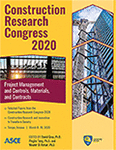Construction Research Congress 2020
Defect Occurrence and Management in Prefabricated Commercial Construction in Australia
Publication: Construction Research Congress 2020: Project Management and Controls, Materials, and Contracts
ABSTRACT
The uptake of prefabrication within the commercial construction sector has significantly increased over previous decades, given the proven benefits including provisions for lower construction costs, reduced project durations, and materials wastage, fewer defects, and improved profitability. However, it is found that defects caused by prefabrication cost significantly more to resolve compared with conventional construction, resulting in substantial impacts on project performance. Furthermore, defect management systems specific to prefabricated construction are found absent, especially within the commercial sector in Australia. This research studies the defect occurrence, identifies the causes of these defects, and proposes defect management for building prefabrication. A mixed research method of combined qualitative and quantitative approaches, i.e., literature review and an online survey, is employed in this research, based on which a depiction outlining common defects and stages of occurrence is presented, and a defect management process is proposed at an empirical level. It is found that most defects occur in manufacturing plant, and aesthetic defect is the most common type. The results also show that most defects can be linked to workmanship issues during fabrication. Subsequently, the management process of engaging an independent consultant employed by the government to undertake specialised inspections during design, manufacture, and installation has been proposed as an effective solution to reduce defect occurrence into the future, for which specific legislation for prefabrication is required.
Get full access to this article
View all available purchase options and get full access to this chapter.
REFERENCES
Abd El-Razek, M, Bassioni, H & Mobarak, A (2008), "Causes of delay in building construction projects in Egypt."Journal of construction engineering and management, 134(11), 831-41.
Ahzahar, N, Karim, N, Hassan, S & Eman, J (2011), "A study of contribution factors to building failures and defects in construction industry," Procedia Engineering, 20, 249-55.
Arashpour, M, Wakefield, R, Lee, E, Chan, R & Hosseini, MR (2016), "Analysis of interacting uncertainties in on-site and off-site activities: Implications for hybrid construction," International Journal of Project Management, 34(7),1393-402.
Ali, A. & Wen, K. (2011). "Building defects: possible solution for poor construction workmanship," Journal of Building Performance, 2(1), 59-69.
Blismas, N (2007), "Off-site manufacture in Australia: Current state and future directions," Cooperative Research Centre for Construction Innovation.
Blismas, N & Wakefield, R (2009), "Drivers, constraints and the future of offsite manufacture in Australia," Construction Innovation, 9(1), 72-83.
Building Construction Authority Singapore 2011, “Common Defects”, https://www.bca.gov.sg/Professionals/IQUAS/others/precastdefect.pdf, retrieved 22 April 2018.
Chan, W-T & Zeng, Z (2003), "Coordinated production scheduling of prefabricated building components," in Construction Research Congress: Wind of Change: Integration and Innovation, pp. 1-8.
Chiang, Y-H, Chan, EH-W & Lok, LK-L (2006), "Prefabrication and barriers to entry—a case study of public housing and institutional buildings in Hong Kong," Habitat international, 30(3), 482-99.
Dahanayake, B & Ramachandra, T (2016), "ASSESSMENT ON DEFECTS OCCURENCE AND REWORK COSTS IN HOUSING CONSTRUCTION SECTOR IN SRI LANKA." Context, vol. 19, p. 86.
Dodoo, A, Gustavsson, L & Sathre, R (2014), "Lifecycle primary energy analysis of low-energy timber building systems for multi-storey residential buildings." Energy and Buildings, 81, 84-97.
Feld, J & Carper, KL (1997), "Construction failure." New York: Wiley, c1997. 2nd ed.
Forsythe, P (2006), "Consumer-perceived appearance tolerances in construction quality management," Engineering, Construction and Architectural Management, 13(3), 307-18.
Fung, IW, Tam, VW & Lo, TY (2012), "Does ISO quality management system improve project performance in a construction project?." NICMAR Journal of Construction Management, 27(23), 53-60.
Jingmond, M & Ågren, R (2015), "Unravelling causes of defects in construction," Construction Innovation, 15(2),198-218.
Karim, K, Marosszeky, M & Davis, S (2006), "Managing subcontractor supply chain for quality in construction," Engineering, Construction and Architectural Management, 13(1), 27-42.
Lehringer, C & Salzgeber, D (2014), "Repair of crack and delaminations in glued laminated timber," in Proc. of the COST Workshop-Highly Performing Timber Structures: Reliability. Assessment, Monitoring and Strengthening, Biel, Switzerland, pp. 43-8.
Papaefthymiou, S, Tzevelekou, T, Antonopoulos, A & Gypakis, A (2016), "Typical defects in plate and long steel products." International Journal of Structural Integrity, 7(5), 645-55.
Park, C-S, Lee, D-Y, Kwon, O-S & Wang, X (2013), "A framework for proactive construction defect management using BIM, augmented reality and ontology-based data collection template," Automation in construction, 33, 61-71.
Salem, O, Solomon, J, Genaidy, A & Minkarah, I (2006), "Lean Construction: From Theory to Implementation." Journal of Management in Engineering, vol. 22, no. 4.
Wardhana, K & Hadipriono, FC (2003), "Study of recent building failures in the United States," Journal of Performance of Constructed Facilities, 17(3), 51-8.
Information & Authors
Information
Published In
Construction Research Congress 2020: Project Management and Controls, Materials, and Contracts
Pages: 871 - 880
Editors: David Grau, Ph.D., Arizona State University, Pingbo Tang, Ph.D., Arizona State University, and Mounir El Asmar, Ph.D., Arizona State University
ISBN (Online): 978-0-7844-8288-9
Copyright
© 2020 American Society of Civil Engineers.
History
Published online: Nov 9, 2020
Published in print: Nov 9, 2020
Authors
Metrics & Citations
Metrics
Citations
Download citation
If you have the appropriate software installed, you can download article citation data to the citation manager of your choice. Simply select your manager software from the list below and click Download.
